
Acronicta euphorbiae, the sweet gale moth, is a moth of the family Noctuidae. The species was first described by Michael Denis and Ignaz Schiffermüller in 1775.

Chersotis margaritacea is a moth of the family Noctuidae. It is found in Central and Southern Europe up to heights of 1,500 meters. Outside of Europe, it is found in Algeria, Morocco, Anatolia, Iran, Georgia, Armenia, Kazakhstan up to the Altai Mountains.

Chersotis cuprea is a moth of the family Noctuidae.

Chersotis multangula is a moth of the family Noctuidae. It is found in the mountainous areas of Central and Southern Europe, Morocco, Turkey, Armenia, Iran, Syria, Lebanon and the Caucasus.
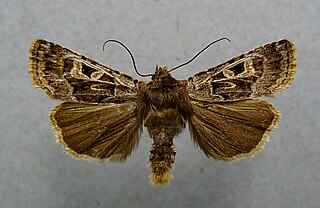
Chersotis ocellina is a moth of the family Noctuidae. It is found in the mountainous areas of Europe, especially in the Alps, the Apennine Mountains, Pyrenees and the Cantabrian mountains.

Euxoa recussa is a moth of the family Noctuidae. The nominate form is found in mountainous areas in Southern Europe as well as the Alps. Euxoa recussa tetrastigma is found Northern Europe, east to Russia, Western Siberia, the Altai Mountains and Amur.
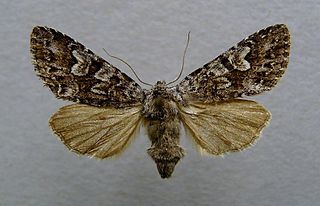
Papestra biren, the glaucous shears, is a moth of the family Noctuidae. The species was first described by Johann August Ephraim Goeze in 1781. It is found in most of Europe, but not in the southern parts of the Iberian Peninsula, Italy and Greece. Outside of Europe it is found in Kashmir and through the Palearctic to Siberia, Central Asia, Amur, Kamchatka, the Russian Far East and Japan. It was introduced in Newfoundland in 1935 and has since then extended its range ever more southward within North America partly overlapping with Papestra quadrata(Smith, 1891). It rises to 2200 m above sea level in the Alps.
Chersotis elegans is a moth of the family Noctuidae. It is found in the mountains of Spain, Greece, Turkey, the Caucasus, Lebanon, Israel and western central Asia.

Standfussiana lucernea, the northern rustic, is a moth of the family Noctuidae. It is found from the Iberian Peninsula, Italy and Greece in southern Europe, north through most of the continent up to Fennoscandia west to Ireland and Iceland.
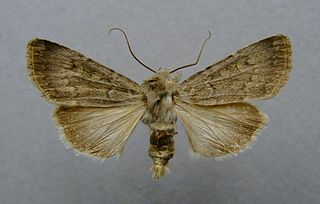
Euxoa decora is a moth of the family Noctuidae. It is found in southern and central Europe, Morocco, Algeria, the Caucasus, Armenia, Issyk-Kul, Turkey, Iran and Iraq.

Epipsilia grisescens is a moth of the family Noctuidae. It is found in Fennoscandia, Denmark as well as the Pyrenees, Alps, Apennines, Balkans and Carpathians. In the Alps it is found up to 2,000 meters.

The Lyme grass is a species of moth of the family Noctuidae. It is found along the coasts of southern Sweden, southern Finland, Denmark, Estonia, northern Poland, northern Germany and eastern Great Britain.

Chersotis larixia is a moth of the family Noctuidae. It is found in Spain, France, Switzerland, Italy and Sicily, Crete, Turkey, and east to Armenia, Azerbaijan, Syria, Iran, Lebanon, and Turkmenistan. In Europe, it is found in mountainous regions, like the Pyrenees, the Alps, and the Maritime Alps, up to heights of 2,000 meters.

Shargacucullia prenanthis, the false water betony, is a moth of the family Noctuidae. It is found from south-eastern France, through the Alps and bordering mountains east to Romania and Bulgaria. It is also found in Anatolia and Lebanon.

The double-spot brocade is a species of moth of the family Noctuidae. It is found in most of Europe, in Turkey and the west of Iran. In Anatolia it is represented by the subspecies Meganephria bimaculosa pontica.

Callopistria latreillei, Latreille's Latin, is a moth of the family Noctuidae. The species can be found in the Palearctic realm, most parts of Europe, Asia, and in Africa from Egypt to South Africa. The habitat consists of rocky limestone slopes with deciduous woodland.

Athetis hospes, or Porter's rustic, is a moth of the family Noctuidae which was described by Christian Friedrich Freyer in 1835. It is found in Spain, southern France, Italy, on the Balkan Peninsula, Crete, Turkey and northern Iran. The species seems to be expanding its range in north-western Europe with records from Great Britain and the Netherlands.
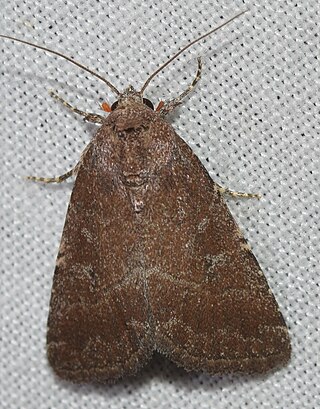
Condica viscosa is a species of moth in the family Noctuidae. It was described by Christian Friedrich Freyer in 1831. It is found from southern Europe and North Africa to Arabia and the southern parts of western Asia. The habitat consists of lowland areas near the coast, including dry slopes, road side verges, dry river beds or fallow land.
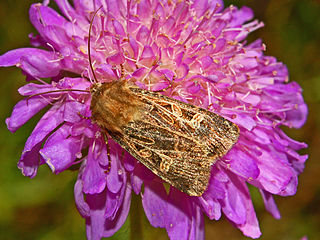
Chersotis alpestris is a moth of the family Noctuidae.

Dichagyris renigera is a moth of the family Noctuidae. It is found in South- and Southeast-Europe, Armenia, Caucasus and Turkey.




















